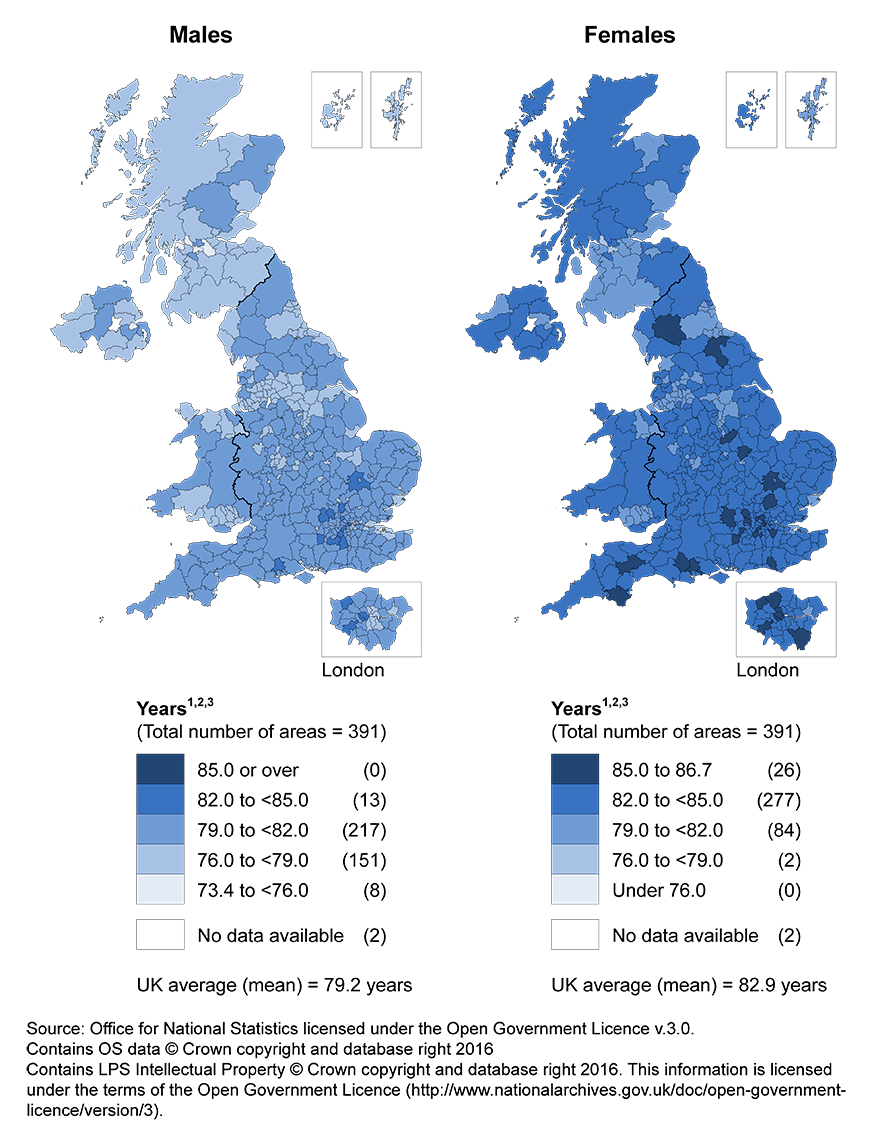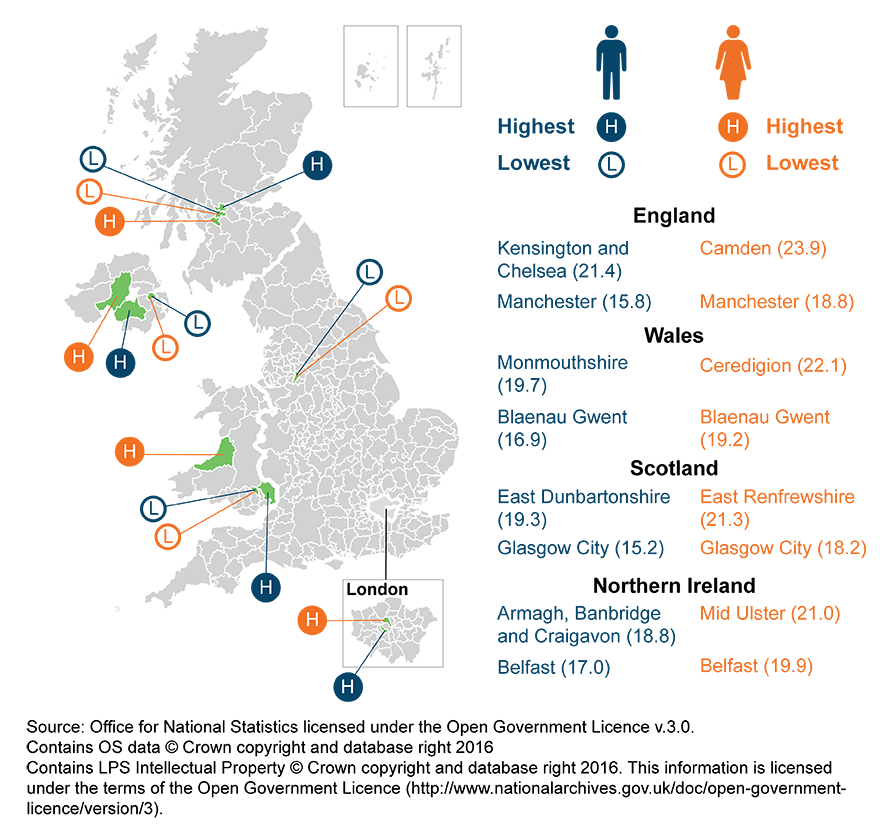As in Education, Wales was devolved a health system which was not quite up to the average standard of facilities throughout the UK. To this add a "sicker" population. We also took over a depressed economy and many areas with inadequate housing and infrastructure. Poorer people tend to have less healthy lifestyles, less adequate housing, and less money to pay for the "extras" available to enhance health, from private services to helpful aids and home modifications.
Since devolution we do live longer, but there is still a significant gap between Wales and England. However, the overall figures show even within Wales there is great variation. Life expectancy is something easy to quantify as births and deaths are registered. Why life expectancy is improving is less clear. Wales is following the trend, but not catching up. Wales may not feel like a rich country but compared with all the world's nations it is one, as it has generally good nutrition and healthcare. However, we should look to improving the standards at least up to the UK average.
Most deaths occur in the elderly and the big killers in 2016 were cancer, 28.5% circulatory illness [heart attack, stroke etc] 25.5% and Alzheimer/other dementia 15.6%. Over 75's are showing a small decrease in mortality.
LIFE EXPECTANCY IN WALES
Last year's [2017] data from IDS Scotland indicates a 1 year lag in the average life expectancy of Welsh men – who live to an average 78.4 years from birth- compared to their English equivalents, with Welsh women trailing behind by 0.8 years in living to an average age of 82.3.
In the field of gross life expectancy the gap between England and Wales is obvious, with the sexes showing similar widening between English and Welsh men and women. The life expectancy increases in both populations but more in England than Wales.


Since devolution we do live longer, but there is still a significant gap between Wales and England. However, the overall figures show even within Wales there is great variation. Life expectancy is something easy to quantify as births and deaths are registered. Why life expectancy is improving is less clear. Wales is following the trend, but not catching up. Wales may not feel like a rich country but compared with all the world's nations it is one, as it has generally good nutrition and healthcare. However, we should look to improving the standards at least up to the UK average.
Most deaths occur in the elderly and the big killers in 2016 were cancer, 28.5% circulatory illness [heart attack, stroke etc] 25.5% and Alzheimer/other dementia 15.6%. Over 75's are showing a small decrease in mortality.
 |
| Prince Phillip Hospital, Llanelli. |
LIFE EXPECTANCY IN WALES
Last year's [2017] data from IDS Scotland indicates a 1 year lag in the average life expectancy of Welsh men – who live to an average 78.4 years from birth- compared to their English equivalents, with Welsh women trailing behind by 0.8 years in living to an average age of 82.3.
In the field of gross life expectancy the gap between England and Wales is obvious, with the sexes showing similar widening between English and Welsh men and women. The life expectancy increases in both populations but more in England than Wales.
Figure 1: Life expectancy for babies at birth by sex and country - ONS
England and Wales, 1991-1993 to 2012-2014
Male - England
Female - England
Male - Wales
Female - Wales
2012–20142007–20092002–20041997–19991992–1994
72.57577.58082.585
Years
1993–1995
● Male - England: 74.18
● Female - England: 79.44
● Male - Wales: 73.42
● Female - Wales: 78.99
● Male - England: 74.18
● Female - England: 79.44
● Male - Wales: 73.42
● Female - Wales: 78.99
Source: Office for National Statistics
Notes:
- Figures are based on deaths registered and mid-year population estimates, aggregated over 3 consecutive years.
- Figures for each country exclude deaths of non-residents.
- Newborn life expectancy has steadily increased in England and Wales since 1991-93. Life expectancy is higher in England then in Wales, while the gap between both countries has widened over the last 2 decades.
- The gap between male and female life expectancy at birth has also narrowed in both countries
Looking at the UK as a whole there is notable variation where, as a rule, poorer areas have poorer health.
Figure 3: Life expectancy (LE) at birth for males and females, by local area, UK, 2013 to 2015

Notes:
- Local areas include lower tier local authorities (LTLAs) in England, unitary authorities in Wales, council areas in Scotland and local government districts in Northern Ireland.
- Isles of Scilly and City of London have been excluded from the map because of insufficient population counts
Poor health does not necessarily mean hospitals or community health resources are lacking. Nutrition, housing, geographical access, education and lifestyle issues are all factors and these figures above are indications only of how long people currently live. In all the UK countries there are sharp differences between the best and worst areas.
Life expectancy at age 65 differs by up to 5.6 years within U.K. countries
Figure 4: Highest and lowest number of years expected to live for men and women at age 65, by local area, UK, 2013 to 2015

In most cases, the highest and lowest life expectancy in areas for males is the same at birth and at age 65. The exceptions are the highest life expectancy at age 65 for Northern Ireland being Armagh, Banbridge and Craigavon (which was Lisburn and Castlereagh at birth) and the lowest life expectancy for England at age 65 being Manchester (which was Blackpool at birth).
The opposite can be seen for females where the majority of highest and lowest life expectancies are different for each country. The only figure that was the same at birth and at age 65 was the lowest life expectancy in Northern Ireland, which was in Belfast.
In Wales we can be proud that people are living longer and larger portions of our lives are spent in reasonable health. This is common amongst developed countries throughout the world and thought to be due to a combination of healthier living and improved routine successful treatment of many medical conditions and prevention of others through vaccination and education.
In Wales the question is always "why the gap?". We know the gap was there before devolution, and this gap remains despite general progress in health and longevity.
How long we live is not only a function of formal healthcare but a range of nutritional, social and environmental factors which affect our health. The current movements to reorganise formal hospital based healthcare in Wales seem to be more related to the needs and difficulties of the health care providers than easy access to provision of healthcare and adequate social care, which is arguably the more pressing concern of the population.
Although most of us now can look forward to living longer, why are we not be living as long as our neighbours?
Siân Caiach

No comments:
Post a Comment
Thank you for your comment which will be display once it has been moderated.